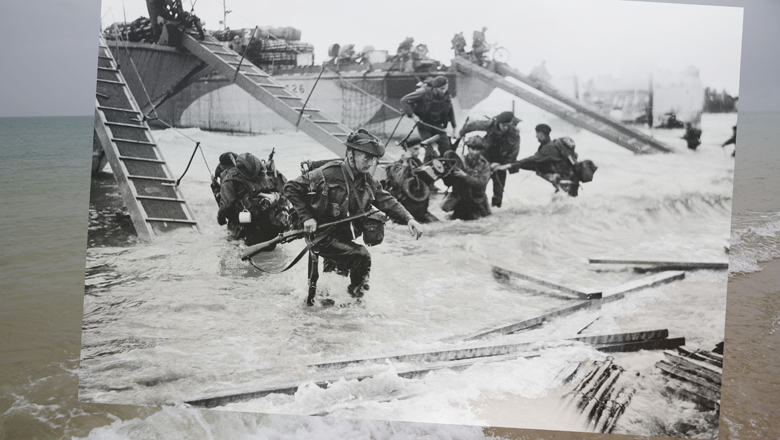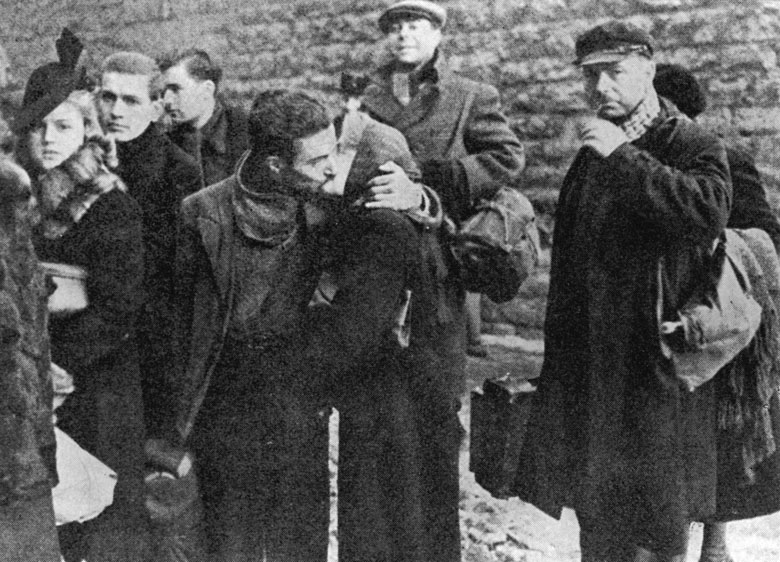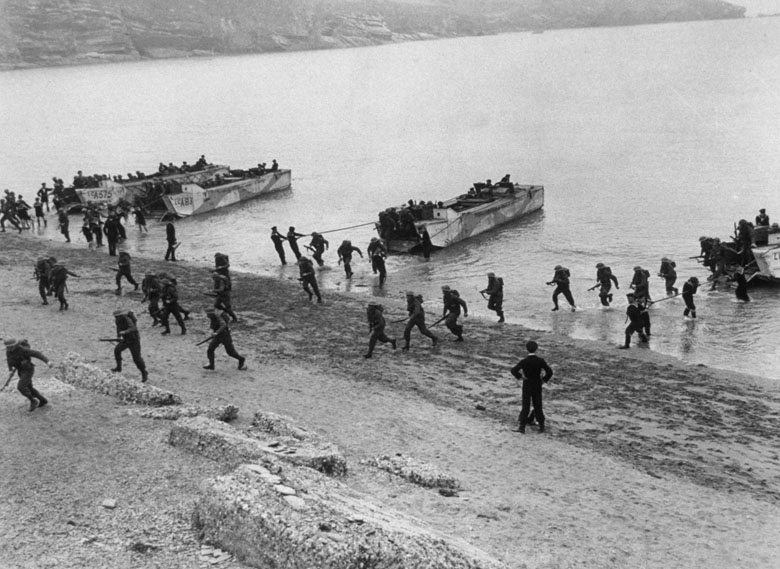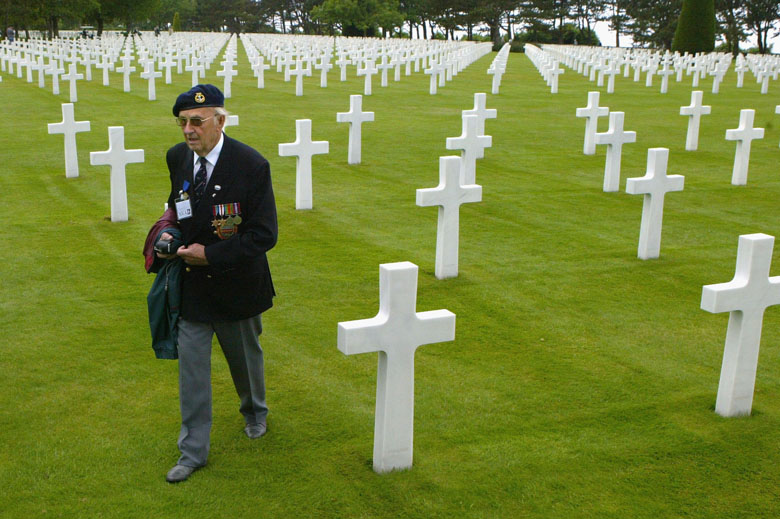
In this composite image a comparison has been made of Saint Aubin sur Mer, France. D-Day took place on June 6, 1944. (Peter Macdiarmid/Getty Images) Lt. Handford/ IWM via Getty Images)
Today is the 73rd anniversary of the Normandy landings in France during World War II on Tuesday, June 6, 1944. Codenamed Operation Neptune, it targeted the Nazis and is the largest seaborne invasion in history.
Operation Neptune was part of the larger Operation Overlord. The belligerents included the Allied forces, consisting of the United States, the United Kingdom, Canada, Australia, Belgium, Czechoslovakia, Denmark, Free France, Greece, the Netherlands, New Zealand, Norway, and Poland, against Nazi Germany.
By late August, all of Nazi-occupied northern France had been liberated from Nazis thanks to Operation Overlord, which started with D-Day. In military terminology, “D-Day” is the day on which any given combat operation begins. Therefore there has been more than one D-Day throughout history, but “Operation Overlord” is the most famous of these. The “D” in “D-Day” does not stand for anything.
D-Day was also a turning point in the war, as it led to the total defeat of Adolf Hitler and his regime.
Here’s what you need to know about this year’s D-Day anniversary:
1. Nazis Had Occupied Northwestern France in 1940

French workers are sent to carry out forced labor for the Nazis, by the Vichy government under Pierre Laval, circa 1942. Only a fraction of those called up complied with the “Compulsory Labor Service” regulation. (Three Lions/Hulton Archive/Getty Images)
After World War II began on September 1, 1939, Germany invaded and occupied northwestern France in early May 1940. France had its collaborators with the Hitler regime and the Nazi-controlled portions of France became known as “Vichy France,” named after Vichy, a city about 200 miles southeast of Paris. Paris remained the de jure capital of France, but Vichy became where occupied France was ruled from.
…Upon being invaded and defeated by Nazi German forces, the autonomous French state had been split into two regions. One was occupied by German troops, and the other was unoccupied, governed by a more or less puppet regime centered in Vichy…
Vichy France was initially headed by Marshal Philippe Petain, a war hero of World War I. He was in his 80s when his Hitler-backed government rose to power in France. Later, Pierre Laval took over Petain’s position. After the war, both Petain and Laval were tried for treason by the government of President Charles de Gaulle, leader of Free France. Because of Petain’s advanced age and history, his death sentence was commuted. However, Laval was executed by firing squad after a botched suicide attempt.
During the rule of the Vichy government, Frenchmen were forced into labor by the Germans. French police were also ordered to round up Jews, many of whom were sent to concentration camps.
2. Operation Neptune Was Kept Secret & Was a Surprise Attack

Troops coming ashore during training exercises for the Allied D-Day invasion. (Keystone/Getty Images)
Prior to D-Day, the Allies carried out Operation Bodyguard, a military deception to confuse the Germans about when and where the invasion of France would begin. Planning for Operation Bodyguard started in 1943. Operation Bodyguard was intended to spread Germany forces thin, as it suggested to them that the Allied invasion would be at a number of distant places, including Pas-de-Calais in northern France, the Balkans, southern France, and Norway.
Operation Bodyguard included a number of smaller operations, including Operation Fortitude, which was created to deceive the Germans about where the D-Day invasion would occur. Fortitude North planned a phony invasion of Norway through Scotland—the Allies rigged the Swedish stock market to make it look like Norway would soon be liberated, and radio chatter sent signals about soldiers obtaining winter gear supplies. Meanwhile, Fortitude South feigned an invasion of France at Calais, through the Straits of Dover. Strategically, this seemed like the best place for an Allied invasion.
Operation Fortitude was the plan to lead the Nazis to believe that the Allies had armies ready in south England to take both Norway and Pas-de-Calais.
Operation Bodyguard also had Nazi leaders thinking that the date of any Allied invasion would be much later than D-Day. The name of “Bodyguard” came from Winston Churchill, who said, “In wartime, truth is so precious that she should always be attended by a bodyguard of lies.”
3. The D-Day Invasions Began at 6:30 A.M.

Troops from the 48th Royal Marines at Saint-Aubin-sur-mer on Juno Beach, Normandy, France, during the D-Day landings, June 6, 1944. (Hulton Archive/Getty Images)
The Normandy landings were originally scheduled for June 5 but were rescheduled to the following day by American General Dwight D. Eisenhower because of poor weather.
On June 6 at 6:30 a.m. local time, Allied forces stormed five sectors on the Normandy coast, all with codenames. The codenames were Utah, Omaha, Gold, Juno, and Sword. History.com writes:
The British and Canadians overcame light opposition to capture beaches codenamed Gold, Juno and Sword, as did the Americans at Utah Beach. U.S. forces faced heavy resistance at Omaha Beach, where there were over 2,000 American casualties. However, by day’s end, approximately 156,000 Allied troops had successfully stormed Normandy’s beaches.
According to War History Online:
An interesting fact is that it was originally planned to name the British-Canadian beaches after fishes ― Goldfish, Swordfish, and Jellyfish, which would be shortened to Gold, Sword, and Jelly. Winston Churchill found the name Jelly inappropriate and disrespectful towards the men who would undoubtedly die there; on his insistence, it was decided that the name should be changed to Juno, the name of an important Goddess of ancient Rome.
As for Utah and Omaha, it is believed they were named by U.S. General Omar Bradley after carpenter Gene Eyler and his colleague, who were from Omaha and Provo, Utah. The two men allegedly built the headquarters where the D-Day invasion was planned, reports Omaha.com.
4. At Least 10,000 People Died That Day

American soldiers kneel in homage at the graves of their dead comrades near Sainte Mere Eglise. (Fred Ramage/Keystone/Getty Images)
At least 10,000 Allied troops were killed on the first day of the initial Normandy invasion. According to the D-Day Museum:
For many years, the Allied casualties figures for D-Day have been estimated at 10,000, including 2,500 dead. Broken down by nationality, the D-Day casualty figures that have been cited for many years are approximately 2,700 British, 946 Canadians, and 6,603 Americans. However recent painstaking research by the US National D-Day Memorial Foundation has achieved a more accurate – and much higher – figure for the Allied personnel who were killed on D-Day. They have recorded the names of individual Allied personnel killed on 6 June 1944 in Operation Overlord, and so far they have verified 2,499 American D-Day fatalities and 1,914 from the other Allied nations, a total of 4,413 dead (much higher than the traditional figure of 2,500 dead). Further research may mean that these numbers will increase slightly in future.
However, for the total operation, it is estimated there were 209,000 Allied casualties.
5. There Have Been Many D-Days

A member of the Folkstone branch of the Normandy Veterans Association walks among the headstones of American soldiers killed in the D-Day invasion June 4, 2004 at Colleville sur Mer, France. (Sean Gallup/Getty Images)
As stated earlier, “D-Day” doesn’t stand for anything.
In military terminology, “D-Day” is the day on which any given combat operation begins. Therefore there has been more than one D-Day throughout history, but “Operation Overlord” is the most famous of these. The “D” in “D-Day” does not stand for anything but is instead used as an indicator to points of time before or after a combat operation begins. For example, D+1 means 1 day after D-Day. H-Hour is also a term used and references the hour on which any given combat operation begins. According to the U.S. Army Center of Military History:
There is but one D-day and one H-hour for all units participating in a given operation. It is unnecessary to state that H-hour is on D-day.
Throughout history there has been A-Day through Z-Day, with only “B-Day” skipped over. Each “Day” with a letter before it as its own militaristic meaning for days and hours. To see a complete list of military designation of days and hours, click here.